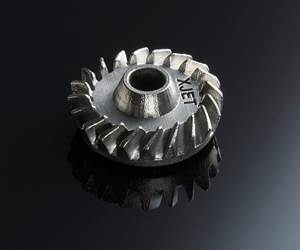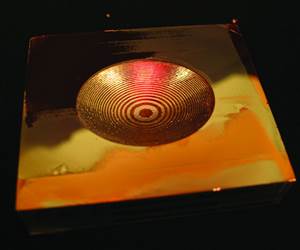AddUp Appoints Julien Marcilly to CEO
Julien Marcilly, who has been with AddUp since 2019 as deputy chief executive officer, stepped into the role of chief executive officer in late 2023, succeeding Frank Moreau.
Julien Marcilly at The AddUp Solution Center, AddUp’s North American subsidiary located in Cincinnati, Ohio. Photo Credit: AddUp
Julien Marcilly, who has been with AddUp since 2019 as deputy chief executive officer, stepped into the role of chief executive officer in late 2023, succeeding Frank Moreau. Marcilly has a strong history in the industrial manufacturing industry with almost 15 years of experience in leadership roles with the Fives Group prior to joining AddUp.
As the CEO of Fives Conveying, Marcilly was committed to helping the world’s largest automakers enhance machine productivity with smart automation solutions. Prior to Fives Conveying, Marcilly was successful as the operations director of Fives Stein supporting large projects and optimizing production lines for steel and glass manufacturers across Europe, Asia, North and South America.
Marcilly’s experience with international manufacturing challenges such as supply chain disruptions, technology adoption, automation and sustainability is expected to benefit AddUp as it continues to grow and expand into new markets and countries.
With a background in traditional manufacturing methods, Marcilly is passionate about metal 3D printing and is convinced it will be a game changer for many large industrial companies. He says he is committed to showing that AddUp has the expertise to support these industrial companies fully and strongly in their 3D printing journey.
“AddUp is a bona fide additive manufacturing OEM built upon the pedigree of our parent companies, industry pioneers, Michelin and Fives,” Marcilly says. “We understand the world of manufacturing because we were born from it. We understand industrial challenges because we have lived them. This is why we are industrializing additive manufacturing. We know how to use it, qualify it and scale it, making it a reliable and repeatable solution for our customers.”
Marcilly says he is honored to step into his new role as CEO for the global metal additive manufacturing (AM) OEM and says that anticipating the future of 3D printing will be a top focus, with priorities on productivity and repeatability, sustainability, software monitoring and data management, all while providing exceptional customer support so they may realize the full potential metal AM has to offer.
“AddUp not only has best-in-class PBF and DED machines but also a best-in-class service team to fully support our customers throughout their additive manufacturing journey from design to production and qualification,” Marcilly says. “I am excited to see the future of additive manufacturing and proud to be at the forefront with AddUp, industrializing the technology to solve manufacturers toughest challenges. I look forward to leading such an innovative company and to driving the growth of our industry.”
AddUp, a joint venture created by Michelin and Fives, is a global metal AM OEM that offers multitechnology production systems, including the FormUp range of open-architecture powder bed fusion (PBF) machines, as well as the BeAM Modulo and Magic lines of industrial directed energy deposition (DED) machines.
AddUp is headquartered in Cébazat, France, with a North American subsidiary based in Cincinnati, Ohio, and a German subsidiary based in Aachen, Germany. In addition to the machine design and manufacturing, the AddUp group also offers part production, POC production, metal AM consulting services, AM training and design for AM.
Related Content
AM 101: NanoParticle Jetting (NPJ)
The proprietary process from XJet builds ceramic and metal parts using nanoparticle suspensions. Learn how NPJ works in this introductory article, part of our AM 101 series.
Read MoreAM 101: What Is Binder Jetting? (Includes Video)
Binder jetting requires no support structures, is accurate and repeatable, and is said to eliminate dimensional distortion problems common in some high-heat 3D technologies. Here is a look at how binder jetting works and its benefits for additive manufacturing.
Read MoreWorld’s Largest Metal 3D Printer Seen at Ingersoll Grand Opening Event
Maker of large additive and subtractive machines adds capacity in Rockford, Illinois.
Read MoreAM 101: What is Ultrasonic Additive Manufacturing?
Going from additive to subtractive can be simple with Ultrasonic Additive Manufacturing (UAM). What is it and how does it work? Learn the basics in this 101 post.
Read MoreRead Next
At General Atomics, Do Unmanned Aerial Systems Reveal the Future of Aircraft Manufacturing?
The maker of the Predator and SkyGuardian remote aircraft can implement additive manufacturing more rapidly and widely than the makers of other types of planes. The role of 3D printing in current and future UAS components hints at how far AM can go to save cost and time in aircraft production and design.
Read MoreHybrid Additive Manufacturing Machine Tools Continue to Make Gains (Includes Video)
The hybrid machine tool is an idea that continues to advance. Two important developments of recent years expand the possibilities for this platform.
Read More3D Printing Brings Sustainability, Accessibility to Glass Manufacturing
Australian startup Maple Glass Printing has developed a process for extruding glass into artwork, lab implements and architectural elements. Along the way, the company has also found more efficient ways of recycling this material.
Read More






















